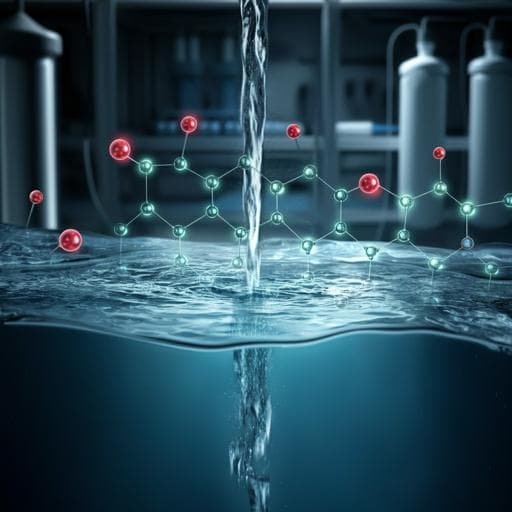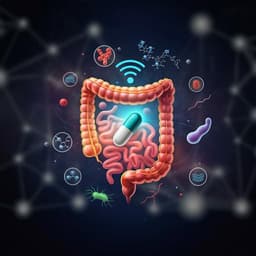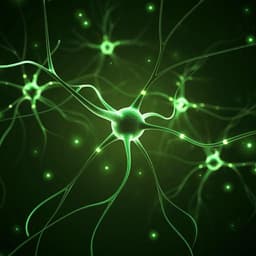
Engineering and Technology
Scalable graphene sensor array for real-time toxins monitoring in flowing water
A. Maity, H. Pu, et al.
Discover groundbreaking research by Arnab Maity and colleagues, who have developed a scalable graphene-based field-effect transistor (GFET) sensor array for real-time monitoring of heavy metals and *E. coli* in drinking water, ensuring safer access to this vital resource.
~3 min • Beginner • English
Introduction
The study addresses the urgent need for continuous, real-time monitoring of contaminants in drinking water, including heavy metals and fecal bacteria, to protect public health and meet global goals for safe water access. While electronic sensors offer advantages over bulky, expensive mass-spectrometry systems for online monitoring, 2D FET sensors face commercialization barriers due to device-to-device variability and lack of non-destructive quality control to identify faulty devices. The research proposes a holistic strategy that combines scalable wet-transfer fabrication of graphene-based FET sensor arrays with impedance- and noise-based pre-screening and machine-learning-assisted calibration to enable reliable, real-time detection of toxins in flowing water.
Literature Review
Prior work has demonstrated 2D material FETs for sensing diverse analytes (heavy-metal ions, gases, biomolecules, bacteria). Commercialization remains challenged by scale-up and quality control leading to variable response and reliability. Efforts to mitigate variability have included large-area CVD growth of 2D materials, printing of thin films, spin-coating and self-assembly. Wet transfer of 2D materials via spin-coating offers an efficient route for large-scale device fabrication, but single-flake device patterning is laborious and costly. Interdigitated electrodes that parallel-connect multiple flakes can scale fabrication and reduce power consumption. However, a comprehensive methodology to identify and isolate faulty devices using non-destructive electrical metrics and to model ideal-device responses with advanced data analysis has been lacking.
Methodology
Fabrication: Monolayer graphene oxide (GO) dispersion (5–10 μm flakes) was spin-coated onto Si/300 nm SiO2 wafers (oxygen plasma pre-treatment). Interdigitated Au electrodes (2 μm finger width, 5 μm spacing, 50 nm thickness) were patterned via lithography. An 80 nm SiO2 protective layer was thermally evaporated to encapsulate electrodes while leaving the sensing region accessible. Wafers were diced; devices were thermally reduced to rGO and received 3 nm Al2O3 by ALD as a top-gate dielectric/passivation. Au nanoparticles were sputtered to serve as probe anchoring sites. Preselection: Devices were initially screened by electronic properties; ~60% exhibited narrow distributions of resistance (~11 ± 1 kΩ) and drain current on/off ratio (~2 ± 0.2). Fault diagnosis (non-destructive testing): AC impedance spectroscopy (1 Hz–5 MHz) was used to evaluate top-dielectric quality, modeling the device as RCH–CDL in series with RCR–CC. The constant-phase element (CPE) parameter n (0–1) indicates dielectric quality; ideal-like devices showed n ≈ 0.91 vs n ≈ 0.79 for defective devices. A practical screening criterion was derived using the low-frequency ratio Z′/Z″, where Z′/Z″ < 1000 identifies ideal-like devices without full spectrum fitting. Low-frequency drain-current noise PSD analysis complemented impedance: 1/f noise behavior consistent with mobility fluctuation (Hooge’s law) was observed; in water β ≈ 2 indicated RTS contribution but absence of G–R Lorentzian humps confirmed acceptable dielectric quality in preselected devices. Probe functionalization: Sensor 1 was modified with L-cysteine for Pb2+ detection; Sensor 2 with thioglycolic acid (TGA) for Hg2+; Sensor 3 with aminoethanethiol (AET), glutaraldehyde (GA), and anti-E. coli O157:H7 antibodies for E. coli detection. Testing platform: A 3D-printed closed-loop flow chamber with a piezoelectric pump circulated tap water across a 3-sensor GFET array. Tap water properties: pH ~7.7; Debye length ~4.5 nm dominated by background ions (Na+, Mg2+, Ca2+, etc.). An Arduino with 16-bit ADC (ADS1115) multiplexed readout; noise spectra were acquired separately on a semiconductor analyzer (~200 Hz sampling). Analyte preparation: Pb2+ (lead nitrate) and Hg2+ (mercury chloride) solutions were prepared in tap water and quantified by ICP-MS (<±5% error). E. coli O157:H7 cultures were prepared and diluted; non-pathogenic E. coli DH5α and Dickeya dadantii 3937 were used for cross-sensitivity checks. Sensing protocol: Sequential dosing of analytes into a background tap-water reservoir with continuous flow; real-time channel resistance monitored. Response defined as Sr = ΔR/R0 × 100%. Cyclic exposure with clean water validated reversibility. Machine learning: Time-domain responses from the three sensors were jointly analyzed. Principal component analysis (PCA) enabled classification of pure and mixed analytes. A two-layer feedforward artificial neural network (ANN; Levenberg–Marquardt training) was optimized for neuron count in the hidden layer and trained to quantify concentrations for Pb2+, Hg2+, E. coli, and their mixtures.
Key Findings
- Fabrication yield: After thermal annealing, ~60% of devices exhibited narrow distributions: resistance ~11 ± 1 kΩ and on/off current ratio ~2 ± 0.2 (±10% around mode values).
- Fault identification via impedance: Ideal-like devices showed CPE parameter n ≈ 0.91; defective devices n ≈ 0.79. A fast screening metric Z′/Z″ < 1000 at low frequency (1–100 Hz) reliably separated ideal-like from non-ideal devices.
- Response kinetics modeling: Bi-directional transients linked to competing gating and defect-induced charge trapping were fitted with R(t) = 1 − exp(−t/τG) − (RT/RG)[1 − exp(−t/τT)]. Setting RT/RG = 0.005 (one order smaller than gating) corresponded to n ≈ 0.91 as a quantitative cutoff for ideal devices.
- Noise spectroscopy: In air, 1/f noise followed Hooge behavior; in water, 1/f PSD with vertical shifts versus Pb2+ concentration indicated chemical gating; β ≈ 2 suggested RTS contribution. Absence of G–R bulges in preselected devices implied acceptable top dielectric quality.
- Real-time sensing in flowing tap water: Distinct, monotonic responses observed concurrently from the 3-sensor array. Maximum response magnitudes at 100 ppb: Pb2+ ~ −10%, Hg2+ ~ −16%; E. coli ~ −45% at 10 cfu/mL. Responses were clearly above background at ~2.5–5 ppb (ions) and ~2.5–5 cfu/mL (bacteria). Cyclic tests showed reversible behavior, with slower desorption than adsorption.
- Selectivity: Minimal cross-sensitivity among sensors; negligible responses to non-target bacteria (E. coli DH5α, Dickeya dadantii 3937). Some cross-sensitivity of Sensor 1 (Pb2+) to high Hg2+ levels was noted and addressed via ML.
- Machine learning: PCA separated target classes and mixtures, with some low-concentration overlap below WHO guideline thresholds. A trained two-layer ANN accurately predicted concentrations of Pb2+, Hg2+, E. coli, and mixtures at ppb (cfu/mL) levels, showing close agreement between predicted and test concentrations.
Discussion
The integrated fabrication and quality-control strategy directly addresses the core challenge of device-to-device variability in 2D FET sensors. By correlating impedance-derived CPE parameters and a practical low-frequency Z′/Z″ metric with transient response behavior, faulty devices can be efficiently excluded without destructive testing. Complementary noise PSD analysis confirms acceptable dielectric/interface quality in preselected devices and clarifies that observed sensing signals are dominated by chemical gating rather than defect-mediated trapping. In flowing tap water, the GFET array functionalized with specific ligands and antibodies concurrently detects cationic heavy metals and negatively charged E. coli with clear, concentration-dependent signals and minimal cross-interference. Combining multi-sensor time-domain data with PCA and ANN enables robust classification and quantification in complex mixtures, overcoming ambiguities inherent to single-sensor calibration in the presence of interferents. These results demonstrate a scalable path to reliable, real-time, multi-target water quality monitoring integrated with existing infrastructure.
Conclusion
The work establishes a scalable GFET sensor array platform for real-time monitoring of heavy metals (Pb2+, Hg2+) and E. coli in flowing tap water, coupling wafer-scale wet-transfer fabrication and interdigitated architectures with non-destructive impedance and noise screening to minimize device variation. A simple low-frequency impedance ratio (Z′/Z″ < 1000) serves as a rapid criterion for selecting ideal-like devices. In-flow detection is achieved at low concentrations (ppb for ions, low cfu/mL for bacteria), and ML models (PCA, ANN) deliver accurate classification and quantification in mixed-analyte scenarios. Future work can broaden the analyte scope (e.g., PFAS and other toxins) by swapping probes and scaling sensor count, implement bias-assisted regeneration and tailored probe design for reversible sensing, and incorporate environmental variables (pH, ionic strength, temperature) into more sophisticated ML models to improve prediction accuracy across diverse water sources.
Limitations
Despite effective pre-screening, thin ALD Al2O3 inherently contains defects contributing to RTS-type noise; device quality relies on careful impedance/noise-based selection. Sensor recovery is slower than adsorption, and reversibility depends on probe–analyte binding kinetics; external biasing or alternative probes may be needed for rapid regeneration. Some cross-sensitivity (e.g., Pb sensor to high Hg2+) persists and requires ML compensation. Tap water properties vary by region (pH, hardness, ionic strength), potentially impacting performance; generalization to diverse waters will benefit from integrating additional environmental parameters into the ML calibration.
Related Publications
Explore these studies to deepen your understanding of the subject.







